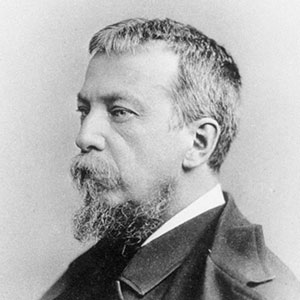
Silas Weir Mitchell
15.02.1829 - 04.01.1914
American physician and writer
Silas Weir Mitchell (February 15, 1829 – January 4, 1914) was an American physician and writer known for his discovery of causalgia (complex regional pain syndrome) and erythromelalgia.
Life
Silas Weir Mitchell was born on February 15, 1829 in Philadelphia, Pennsylvania to John Kearsley Mitchell.
He studied at the University of Pennsylvania in that city, and received the degree of MD at Jefferson Medical College in 1850. During the Civil War he had charge of nervous injuries and maladies at Turners Lane Hospital, Philadelphia, and at the close of the war became a specialist in neurology. In this field Mitchell's name became prominently associated with his introduction of the rest cure, subsequently taken up by the medical world, for nervous diseases, particularly neurasthenia and hysteria. The treatment consisted primarily in isolation, confinement to bed, dieting, electrotherapy and massage; and was popularly known as 'Dr Diet and Dr Quiet'. His medical texts include Injuries of Nerves and Their Consequences (1872) and Fat and Blood (1877). Mitchell's disease (erythromelalgia) is named after him. He also coined the term phantom limb during his study of an amputee.
Silas Weir Mitchell discovered and treated causalgia (today known as CRPS/RSD), a condition most often encountered by hand surgeons. He is considered the father of neurology as well as an early pioneer in scientific medicine. He was also a psychiatrist, toxicologist, author, poet, and a celebrity in America and Europe. His many skills and interests led his contemporaries to consider him a genius on par with Benjamin Franklin. His contributions to medicine and particularly hand surgery continue to resonate today.
In 1866 he wrote a short story, combining physiological and psychological problems, entitled "The Case of George Dedlow", in the Atlantic Monthly. From that point onward, Mitchell, as a writer, divided his attention between professional and literary pursuits. In the former field, he produced monographs on rattlesnake venom, on intellectual hygiene, on injuries to the nerves, on neurasthenia, on nervous diseases of women, on the effects of gunshot wounds upon the nervous system, and on the relations between nurse, physician, and patient; while in the latter, he wrote juvenile stories, several volumes of respectable verse (The Hill of Stones and Other Poems was published in 1883 by Houghton, Mifflin and Co.); he also wrote prose fiction of varying merit, which nonetheless gave him a leading place among the American authors of the close of the 19th century. His historical novels, Hugh Wynne, Free Quaker (1897), The Adventures of François (1898), The Youth of Washington (1904) and The Red City (1909), take high rank in this branch of fiction.
He was Charlotte Perkins Gilman's doctor and his use of a rest cure on her provided the idea for "The Yellow Wallpaper", a short story in which the narrator is driven insane by her rest cure.
His treatment was also used on Virginia Woolf, who wrote a savage satire of it in her novel Mrs. Dalloway (1925): "you invoke proportion; order rest in bed; rest in solitude; silence and rest; rest without friends, without books, without messages; six months rest; until a man who went in weighing seven stone six comes out weighing twelve".
Influence on Freud
Sigmund Freud reviewed Mitchell's book on The Treatment of Certain Forms of Neurasthenia and Hysteria in 1887; and used electrotherapy in his work into the 1890s.
Freud also adopted Mitchell's use of physical relaxation as an adjunct to therapy, which arguably resulted eventually in the employment of the psychoanalytic couch.
Honors and recognition
Mitchell's eminence in science and letters was recognized by honorary degrees conferred upon him by several universities at home and abroad and by membership, honorary or active, in many American and foreign learned societies. In 1887 he was president of the Association of American Physicians and in 1908–09 president of the American Neurological Association.
The American Academy of Neurology award for young researchers, the S. Weir Mitchell Award, is named for him.
Crotalus mitchellii, the speckled rattlesnake, was named after Mitchell.
This article uses material from the Wikipedia article Silas Weir Mitchell, which is released under the Creative Commons Attribution-Share-Alike License 3.0. ( view authors).